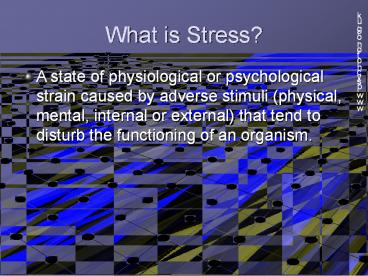What is Stress? - PowerPoint PPT Presentation
Title:
What is Stress?
Description:
What is Stress? A state of physiological or psychological strain caused by adverse stimuli ... Physiological Stress Response. Sudden and severe stress generally ... – PowerPoint PPT presentation
Number of Views:3967
Avg rating:3.0/5.0
Title: What is Stress?
1
What is Stress?
www.psychlotron.org.uk
- A state of physiological or psychological strain
caused by adverse stimuli (physical, mental,
internal or external) that tend to disturb the
functioning of an organism.
2
Physiological Stress Response
www.psychlotron.org.uk
- Sudden and severe stress generally produces
- Increase in heart rate
- Alterations in digestive activity
- Skin becomes pale
- Sweating increases
- Muscular tremors
- These responses are produced by the
Hypothalamic-Pituitary-Adrenal Axis (HPAA)
3
Physiological Stress Response
www.psychlotron.org.uk
The stress response occurs when we are exposed to
some sort of threat. It involves co-ordinated
responses from a number of different systems and
structures
Hypothalamus
Pituitary gland
Sympathetic ganglia
Adrenal cortex
Adrenal Medulla
Finish
4
The Hypothalamus
www.psychlotron.org.uk
The hypothalamus is in charge of the stress
response. When a stress response is triggered, it
sends signals to two other structures the
pituitary gland, and the sympathetic ganglia.
Hypothalamus
Pituitary gland
Sympathetic ganglia
Adrenal cortex
Adrenal Medulla
Finish
5
The Pituitary Gland
www.psychlotron.org.uk
The pituitary gland controls the glands of the
endocrine system. When activated by the
hypothalamus it releases ACTH, which activates
the adrenal cortex.
Hypothalamus
Pituitary gland
Sympathetic ganglia
Adrenal cortex
Adrenal Medulla
Finish
6
The Sympathetic Ganglia
www.psychlotron.org.uk
The sympathetic ganglia are connected to the
internal organs. When activated they affect the
functioning of the lungs, heart and digestive
system. They are also connected to the adrenal
medulla
Hypothalamus
Pituitary gland
Sympathetic ganglia
Adrenal cortex
Adrenal Medulla
Finish
7
The Adrenal Cortex
www.psychlotron.org.uk
The adrenal cortex releases chemicals called
corticosteriods. These have a number of functions
including releasing stored glucose and
controlling swelling after injury.
Hypothalamus
Pituitary gland
Sympathetic ganglia
Adrenal cortex
Adrenal Medulla
Finish
8
The Adrenal Medulla
www.psychlotron.org.uk
The adrenal medulla releases adrenaline. This
hormone stimulates the sympathetic ganglia,
keeping their activity at a high level.
Hypothalamus
Pituitary gland
Sympathetic ganglia
Adrenal cortex
Adrenal Medulla
Finish
9
Fight or Flight Response
www.psychlotron.org.uk
Increase oxygen intake
Release stored glucose
Divert resources away from digestion
10
The Fight or Flight Response
www.psychlotron.org.uk
- An early evolutionary adaptation that is useful
in dealing with physical threats - Helps us deal with short-term problems that can
be solved by fighting or running - Unfortunately, many of the threats we face in our
society do not fall into these categories































